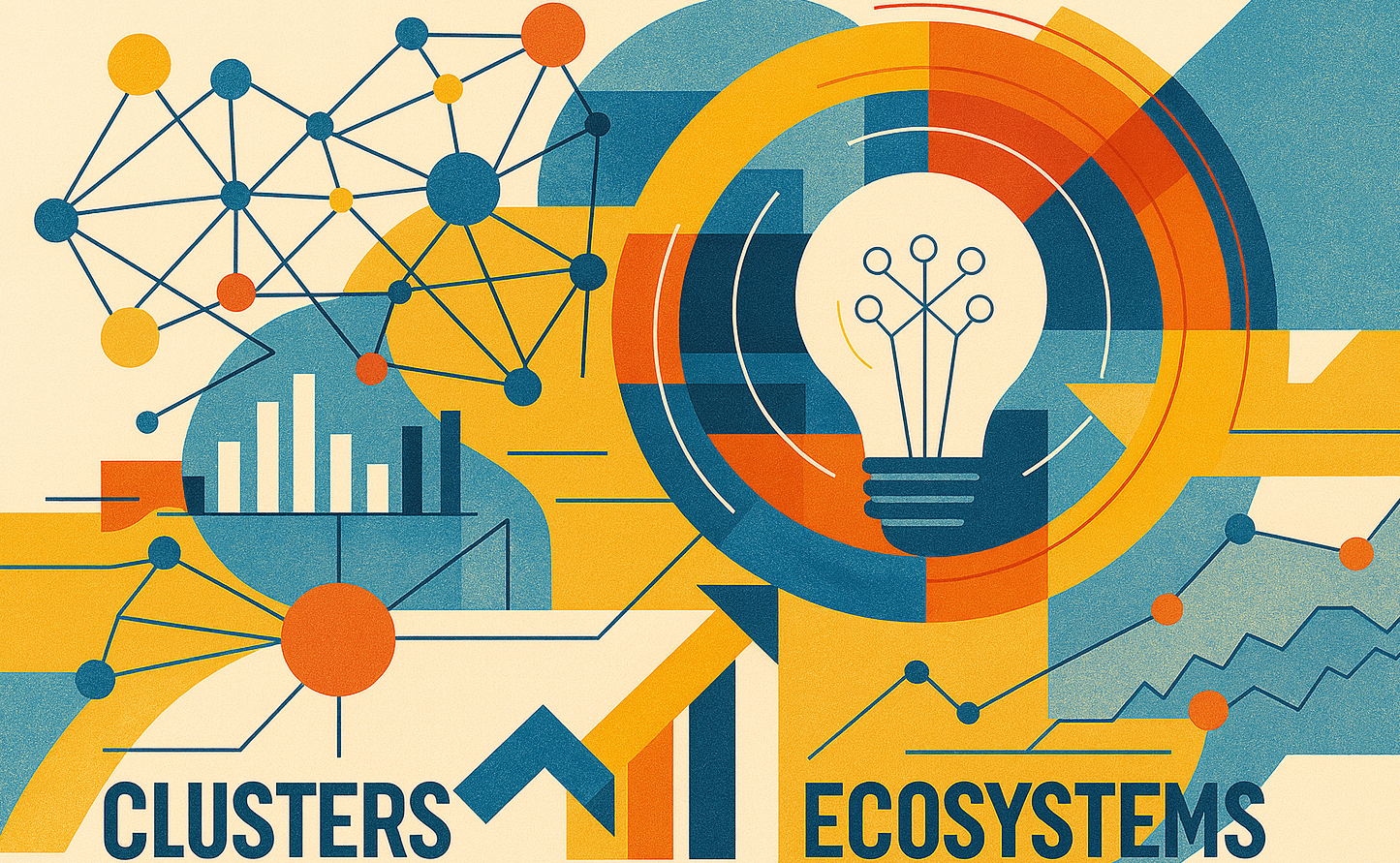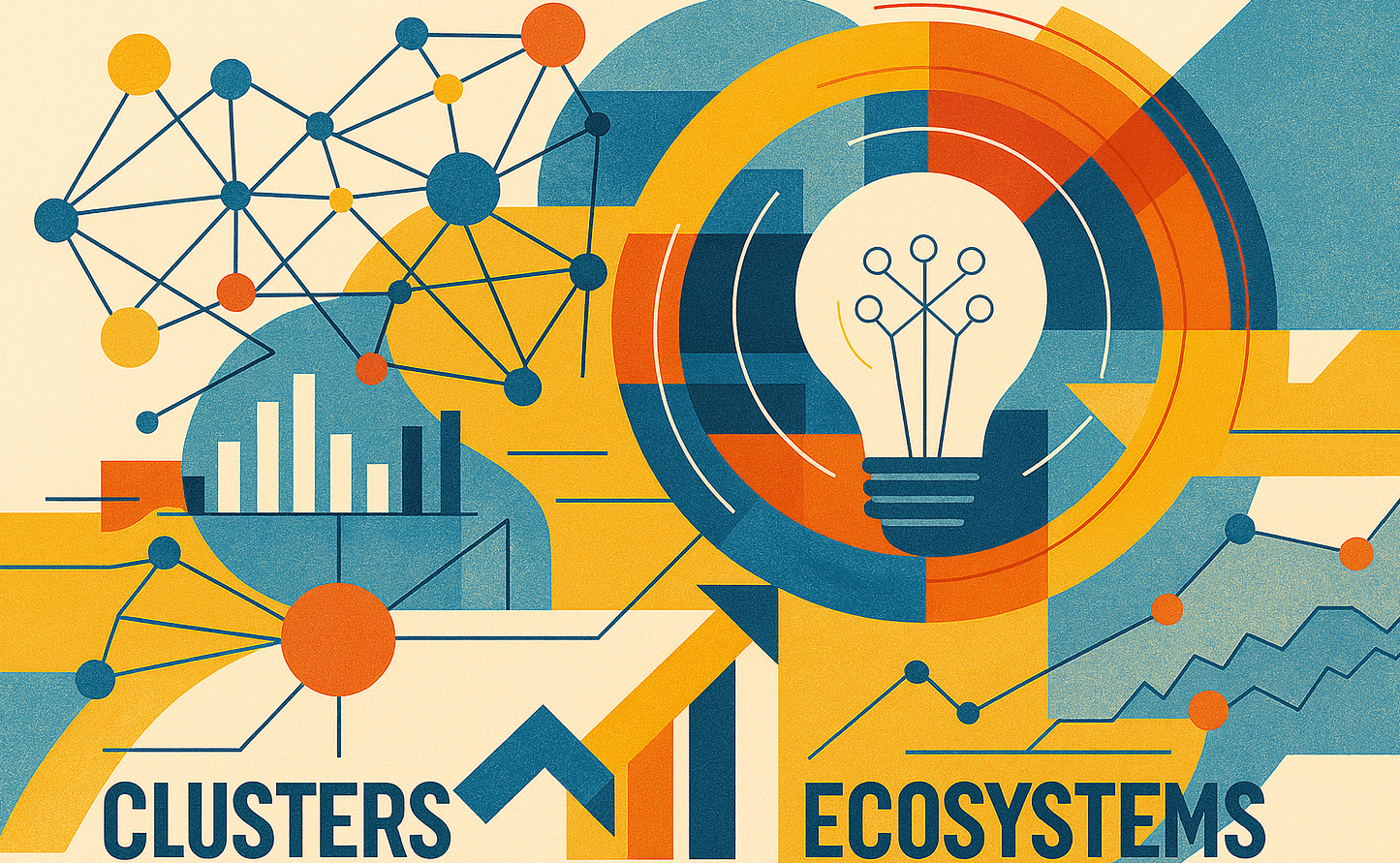
Emerging Shifts in Clusters and Innovation Ecosystems: Insights from New Zealand – Insights from Dale Pearce, Ecosystem Strategist & Designer

New Zealand is developing a vibrant Cluster and Innovation Ecosystem Community under the umbrella of Economic Development New Zealand (EDNZ), led by experienced strategy and innovation consultant Dale Pearce (previously Head of five clusters at ChristchurchNZ). This community of practice connects people working across clusters, innovation hotspots and entrepreneurial ecosystems to share insights, surface common barriers, and test new ways of working. Drawing on Dale’s work with multiple clusters and sectors, the initiative is introducing new capabilities designed to accelerate the success of clusters and innovation ecosystems and to evolve the traditional cluster model into something more dynamic and mission-driven.
The community has identified a number of common barriers, which are informing new conversations.
Mobilising Cluster Initiatives and Building Collaboration
A core challenge is how to build trust and collaboration at speed — both within clusters and across them — while also achieving critical mass and identifying a compelling platform for joint action. Traditional bottom-up approaches to economic development can be slow. Addressing this challenge involves exploring ways to accelerate time to results by identifying innovation hotspots early, catalysing initiatives quickly and evolving them rapidly. This involves looking at the different stages of cluster evolution, highlighting what works at each phase, and testing new models that bring together diverse actors sooner.
Attracting Investment without a National Cluster Programme
Unlike many countries, New Zealand has no dedicated government-funded cluster program, and its innovation ecosystem is often described as fragmented. This creates both challenges and opportunities. Without a national policy framework, clusters must innovate in how they attract investment through value-adding partnerships, demonstrating clear returns for funders. Multiple actors across the ecosystem — public, private, academic and civic — must be mobilised in service of shared impacts, beginning with a clear vision, defined objectives, and a deep understanding of the new value that the collaboration can create and capture. Rather than “selling clustering” as a policy framework, each region or “place” needs to articulate a place-based strategy, distinct value proposition and show funders how collaborative approaches deliver concrete results.
Measuring Cluster Value through the Ecosystemic Balanced Scorecard
Funders often ask, “how do you measure the value of clusters?” Too often, measurement is confined to lagging indicators like job numbers, GDP growth or total investment value. To address this, Dale - an experienced Balanced Scorecard practitioner - has introduced a way of programmatically and iteratively demonstrating value across clusters and ecosystems. This “ecosystem scorecard” translates vision and ambition into shared objectives, measures, targets and initiatives, showing how short-term wins drive longer-term transformation. It provides a framework for rolling evaluation and helps demonstrate the diverse types of value being created and captured - from economic growth to sustainability and inclusion.
Clusters vs. Ecosystems: Understanding the Alternatives
Another recurring question is “when is a cluster a cluster — and what are the alternatives?” Clusters can emerge incrementally from existing strengths or be intentionally built around new specialisations (for example, an abundance of green energy paving the way for a cleantech precinct). It’s important to compare clusters with other models — innovation hotspots, business ecosystems, entrepreneurial ecosystems, precincts — and explore why these ecosystems matter to regional development. This includes understanding systems transitions and the role regional ecosystems can play from the ground up.
Shaping Ecosystems and Supply Chains
Connecting clusters nationally and internationally is another priority. As an example, offshore wind development off New Zealand’s West Coast will require an ecosystem to be shaped -drawing on expertise and supply chains that already exist elsewhere. The question becomes: how can New Zealand attract ecosystem actors, link them to local initiatives, and proactively cluster internationally to shape robust supply chains? This approach positions clusters not as isolated regional initiatives but as nodes in a global network of ecosystems.
Learning from Global Open Innovation Leaders
Dale’s approach draws from multiple theories and global thought leaders:
- Participating in the Berkeley Open Innovation Seminars led by Professor Henry Chesbrough.
- Collaborating with Dyan Finkhousen (Shoshin Works, ex GE Open Innovation) and exploring ecosystemic models with NASA CAS.
- Participating in a global community led by Jon Winsor (Harvard Laboratory for Innovation Science / Open Assembly).
- Working with leading AI-enabled platforms and marketplaces such as Spigit, Datascouts, Wazoku and InnoCentive.
- Implementing projects across Defence, Agritech, Energy, Economic Development, Aerospace and Health sectors.
This diverse exposure is helping shape a uniquely New Zealand perspective on clusters and innovation ecosystems. As Head of Economic Clusters at Christchurch NZ, Dale drew on her extensive and unique experience to build a phased approach to identifying and developing ecosystemic and place-based strategy. This contributed to the recently published Aerospace in Canterbury Strategy.
Beyond “Old Wine in New Bottles”: Mission-Oriented Innovation
Transformative innovation must be central to place-based economic development. Dale argues that we need to move beyond what economist Mariana Mazzucato calls “old wine in new bottles”.
Clusters and ecosystem organisations need to provide directionality — focusing on problems or missions to be solved. By using a Mission-Oriented Innovation approach, clusters attract and orchestrate diverse industries and disciplines around specific challenges. For example, reducing methane emissions from ruminant animals is a pressing challenge in New Zealand and other similar agricultural systems globally. By identifying such missions, regions can create simultaneous outcomes — economic growth, sustainability, circularity and inclusiveness.
Dynamic Capabilities at the Regional Level
The model is designed to build new and essential capabilities within Economic Development Agencies, Councils, Business Chambers and Cluster Organisations. These organisations need to play a new role, that of ecosystem orchestrator and backbone organisation, and to do this they need to develop Dynamic Capabilities at the regional level — a concept developed by economist David Teece. This is the collective ability to sense new opportunities and threats, seize them, and transform systems and competencies to adapt to rapidly changing environments.
1. Sensing and Connecting Capabilities involves:
- Strategic horizon scanning with a medium to long-term outlook (“always on” monitoring and sense-making).
- Mapping ecosystems to understand actors, strengths and weaknesses.
- Using AI to automate profiling of firms, networks, customers and funders, and to spot look-alike actors globally.
- Providing a digital space for members to communicate, share knowledge, opportunities and challenges.
- Offering shared services such as trend monitoring, early-indicator tracking, and community-building around common problems (e.g. synthetic protein, green energy).
- Running open challenges and matching start-ups to funding.
2. Seizing Capabilities
- Decision-making processes that leverage sensing and connecting data.
- Governance structures integrating diverse strategies and resources aligned with mission-oriented innovation.
- Open resource and asset orchestration across industries (for example, linking biomass, transport, distributed production and future fuels in pursuit of net zero).
- Data-driven, multi-actor decision-making aligned with the shared agenda.
3. Transforming Capabilities. The creation and capture of new value require systemic shifts. The process begins by Building the Shared Agenda. The Shared Agenda is used to mobilise bottom-up effort to solve challenges. This is key to engaging funders, industry, investors, academia:
- Inspired by Porter and Kramer’s “Creating Shared Value,” used in the EU to mobilise bottom-up transformation for the SDGs.
- A Shared Agenda is a multi-actor approach to solving problems. It involves developing a shared vision and deep understanding of stakeholder needs to mobilise collective behaviour.
- Using an ecosystemic Balanced Scorecard to measure progress and guide attraction, infrastructure, funding and talent strategies.
- Operate a rolling portfolio of initiatives designed to deliver benefits and transformation, focusing on shaping the business, digital and physical environment.
Overcoming Ecosystem Fragmentation
These capabilities are developed through the ecosystem and cluster development framework, directly addressing long-standing innovation ecosystem problems such as:
- Start-ups struggle to access corporates, buyers or support mechanisms.
- Corporates and investors lack visibility into emerging innovations and talent pools.
- Government, district and city authorities have limited channels to engage communities and gather diverse perspectives for decision-making.
- Academic institutions operate in silos with limited structured engagement with industry and civic actors.
By providing shared services and acting as a trusted backbone organisation, clusters/EDA’s can connect these dots, reduce barriers to growth, and capture missed opportunities for collaboration, driving economic, environmental and social progress.
Digital and AI platforms can also be used to support the new capabilities. Collectively, several platforms combine to create a first-of-its-kind open innovation marketplace. Technologies support the evolution of a Shared Digital Infrastructure delivering multiple use cases that connect a region’s fragmented ecosystem of start-ups, SMEs, academia, government, tourists and citizens, creating a place where talent and innovation want to be. Such platforms:
- Allow start-ups and SMEs to showcase innovations and connect with industry, investors and partners.
- Host open challenges to solve pressing problems.
- Offer access to grant applications, mentors and skills development.
- Empower the region to make more democratic decisions by crowdsourcing input and solutions from citizens.
- Enable industry to tap into a vibrant marketplace of diverse solutions and talent.
- AI enabled always on Intelligence: build and test assumptions, find funders, evaluate futures hypothesis.
Distributed operating models enable and resource system transformation. Different actors undertake different roles and have different capabilities, but the process being orchestrated by a trusted, independent backbone organisation such as a cluster or innovation ecosystem coordinator is essential. A rolling portfolio of initiatives defined through the Shared Agenda can be implemented by different organisations yet coordinated through the Backbone. This is not a linear process but an intelligent governance model that enables regions to move faster and adapt continuously.
Towards a New Role for Clusters and Innovation Ecosystems
Taken together, these practices represent a step change in the role of clusters and innovation ecosystems. Rather than being static groupings of firms, they become innovation backbones and orchestrators — sensing opportunities, seizing them through data-driven, multi-actor governance, and transforming systems to meet shared missions. This approach gives regions the agility to turn local strengths into globally connected innovation engines, driving outcomes for people, places and planet.




